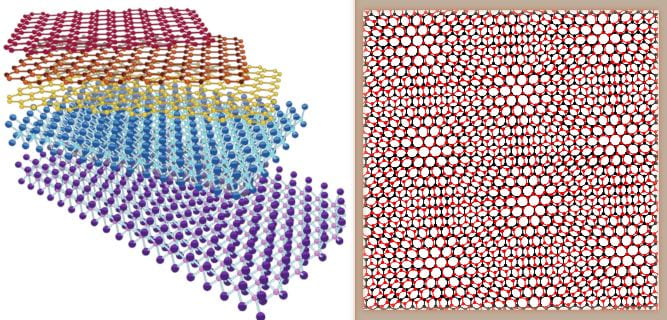Quantum materials, such as graphene, are materials that derive their properties from special quantum features of the underlying atoms. Despite their great technological promise, the development of new quantum materials often involves arduous trial-and-error, due to the sheer number of possible ways in which atoms can be arranged.
In a new Perspective article in Nature Nanotechnology, Justin Song (Nanyang Technological University, Singapore) and his co-author Nathaniel Gabor (University of California at Riverside, USA) envision a more targeted approach to designing quantum materials. They advocate utilizing van der Waals (vdW) heterostructures, which are created by stacking atomically-thin two-dimensional sheets, as shown in the left panel of the figure below.

Left: Schematic of a vdW heterostructure, created by stacking atomic sheets. Right: When two honeycomb meshes are overlaid on each other, the combination produces a moiré pattern which does not appear in the individual meshes. Figure credits: N. Gabor and J. C. W. Song.
Such stacks are exciting because they can exhibit “emergent” features that do not appear in the individual 2D sheets. The phenomenon is analogous to the everyday observation that when two meshes are overlaid on each other, a hypnotic “moiré pattern” can appear, as shown in the right panel of the figure.

Justin C. W. Song, an Assistant Professor in the Division of Physics and Applied Physics at SPMS, NTU.
Song and Gabor draw an analogy between vdW heterostructures and photonic metamaterials, artificial materials used in optical physics to create cloaking devices, super-lenses, and other exotic devices. “Just as subwavelength patterns mold the flow of light in optical metamaterials, the nanoscale features of vdW stacks can transform how electrons flow through the quantum metamaterial,” explains Song.
Although optical metamaterials have undergone extensive research over the past 20 years, the special properties of vdW heterostructures have only just begun to be appreciated by researchers. The multiple ways of arranging 2D materials into stacks provide a simple “toolbox” for researchers to engineer new material properties.
In their article, Song and Gabor point out that quantum metamaterials can open even more possibilities than their optical metamaterials counterparts, because electrons are charged and can strongly interact with each other, whereas photons do not interact. “Examples of unusual quantum behavior in vdW heterostructures have recently been popping up in disparate parts of the field,” says Song, pointing to recent results on vdW heterostructures from research groups around the world. “We wondered if there could be some broad unifying framework, or if a set of strategies could be formulated for quantum engineering.” They envision engineering interactions between electrons to produce collective electronic phenomena, such as new forms of superconductivity, not found in conventional materials.
Reference:
